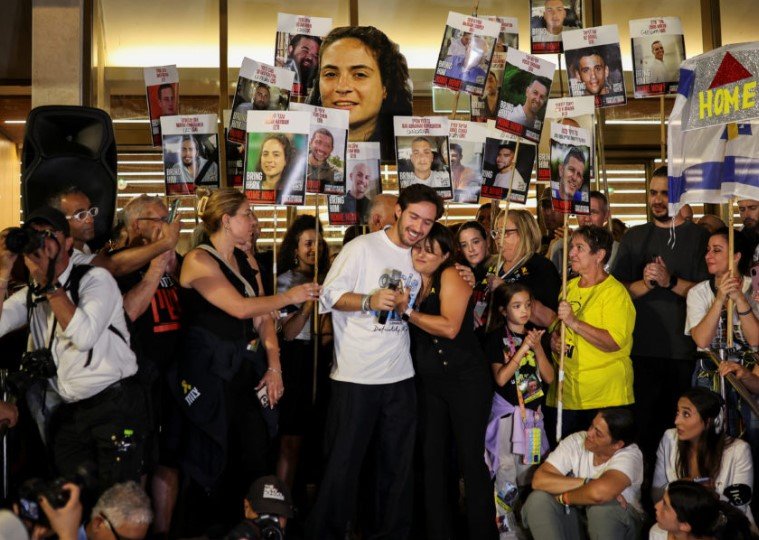In a historic moment on October 13, 2025, Hamas released the last 20 living Israeli hostages after 738 days in Gaza captivity, sparking massive celebrations in Tel Aviv’s Hostage Square. This release, part of a US-brokered ceasefire deal involving President Donald Trump, brought tears of joy and hope for lasting peace while revealing grim details of the hostages’ suffering.
Historic Release Unfolds in Tel Aviv
Crowds gathered in Hostage Square, a symbol of resilience since the October 7, 2023 attacks, as live footage showed the hostages being handed over to the Red Cross and then to Israeli forces. People cheered, hugged, and sang national anthems, with names announced over loudspeakers triggering waves of emotion.
The event marked the end of a two-year ordeal for the captives, who included men kidnapped during the initial Hamas assault. Israeli Prime Minister Benjamin Netanyahu welcomed President Trump in Tel Aviv, where they embraced amid the celebrations. Families rushed to reunite, some seeing loved ones for the first time in over 700 days.
This release followed intense negotiations, with Israel agreeing to free nearly 2,000 Palestinian prisoners in exchange. The deal also included the return of four bodies, ensuring all known hostages were accounted for.

Key Details of the Ceasefire Agreement
The peace deal, finalized just days earlier, outlined a structured exchange to end the Gaza conflict. It required Hamas to release all living hostages within 72 hours of Israel’s partial troop withdrawal, without propaganda events.
Negotiations involved multiple stages, building on earlier proposals from 2024 that offered temporary truces for partial releases. This final agreement emphasized a full ceasefire, prisoner swaps, and aid access to Gaza.
Here is a timeline of major events leading to the release:
| Date | Event Description |
|---|---|
| October 7, 2023 | Hamas attacks Israel, kidnaps over 200 hostages. |
| November 2023 | Initial small releases during brief pauses. |
| February 2025 | Testimonies from earlier freed hostages reveal harsh conditions. |
| October 9, 2025 | Deal approved; 72-hour countdown begins. |
| October 13, 2025 | All 20 living hostages released in Gaza. |
This structure prevented delays and ensured safety for all involved.
The agreement also addressed long-term peace, with commitments to rebuild Gaza and secure borders. Experts note this as the largest prisoner exchange in the conflict’s history, surpassing past deals by involving thousands.
Grim Realities of Captivity Emerge
Survivors shared harrowing stories of their time in Gaza tunnels, painting a picture of extreme hardship. Many endured starvation, with diets limited to bread, rice, and occasional seawater, leading to severe weight loss.
Physical abuse was common, including beatings and being bound in chains. Some hostages reported injuries, like eye damage, and the constant fear of bombings overhead.
Key details from survivor accounts include:
- Constant darkness in underground tunnels, causing disorientation and health issues.
- Limited medical care, with wounds left untreated for months.
- Psychological torment, such as isolation and threats of execution.
These revelations highlight the human cost of the conflict. Medical teams in Israel now assess the hostages, noting that full recovery could take years due to malnutrition and trauma.
One anonymous former captive described relearning to walk after prolonged chaining. Such stories underscore the urgency of mental health support post-release.
Public and Family Reactions to the Freedom
In Tel Aviv, the atmosphere turned electric as crowds watched the releases on giant screens. A young woman named Tal expressed overwhelming relief, calling it the most wonderful day after fearing it might never come.
Families described mixed emotions, from joy to concern over the hostages’ frail appearances. Many waved Israeli flags and lit candles in memory of those who did not return.
Around the world, reactions poured in. Supporters in the US and Europe held vigils, while Palestinian communities celebrated the prisoner releases. Social media buzzed with videos of reunions, trending under hashtags like #HostagesHome.
Road to Recovery and Healing Ahead
The freed hostages now enter specialized care programs in Israeli hospitals. Doctors expect months of physical therapy to rebuild strength lost from poor nutrition and confinement.
Mental health experts stress the need for trauma counseling, drawing from past hostage situations like the 1979 Iran crisis or recent Ukraine releases. Support groups form to help families cope.
Communities rally with fundraisers and welcome events, aiming to reintegrate the survivors smoothly.
Broader Impact on Middle East Peace
This deal signals a potential turning point in the Israeli-Palestinian conflict. With Trump’s involvement, it builds on his previous Abraham Accords, fostering dialogue among regional leaders.
Analysts predict increased aid to Gaza and economic rebuilding, possibly reducing future tensions. However, challenges remain, including verifying all remains and ensuring ceasefire compliance.
Recent events, like the 2024 prisoner swap proposals, show how diplomacy evolved amid global pressure. If upheld, this could inspire similar resolutions in other conflicts.
What do you think about this historic release? Share your thoughts in the comments and spread the word to keep the conversation going.
